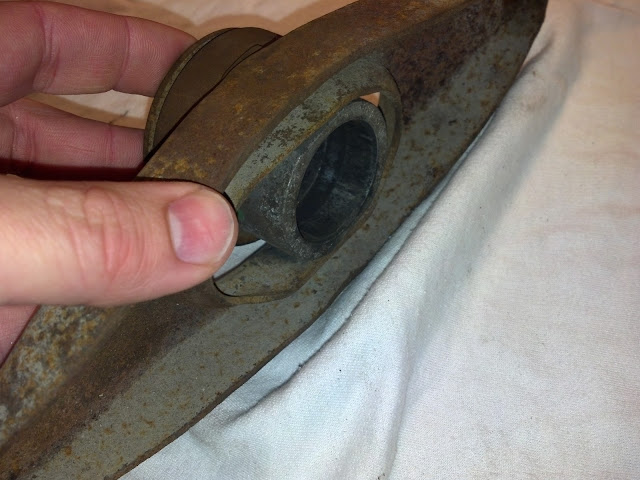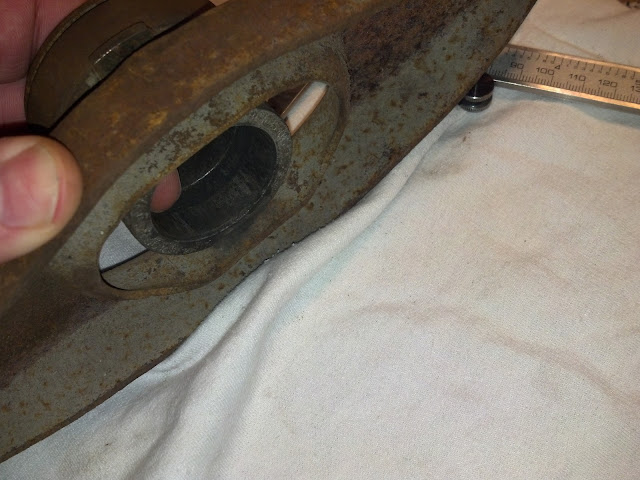Help Needed - Clutch Fabrication Issue
#1
I'm doing a conversion here with a BMW transmission and I need to know if my plan of attack should work or not. If others have a better idea, please feel free to share. After I've setup the flywheel, clutch disc, pressure plate, clutch fork, and throw out bearing, I've arrived with an air gap between the throw out bearing and the pressure plate of about 3/8" or 0.375" + maybe 0.125" (hard to measure). Based on my research I need an airgap of around 0.125" to insure proper geometry and release of the clutch through pedal actuation.
These are some old parts for reference... the new ones are already on the engine/trans. Here is the how the release bearing sits in the clutch fork. Take notice of the backside how the bearing sits flush with the back of the fork.



Also note the two little tabs or 'tangs' that ride against the clutch fork surface.

Everyone should be familiar with this but to recap - the quill tube goes through the center of the throw out bearing and that sets up bearing concentricity with the pressure plate. The fork rides on those tangs and they move together on the quill tube when the slave cylinder extends and presses on the one side of the fork.
With that in mind, again I measured the airgap distance to be about 0.375" or 3/8". So I need to decrease this so I have around 0.010" between the bearing and the pressure plate. What I had in mind was to weld on two additional tabs to the tangs to space it out that 0.375". I took a couple pictures to show you what I'm planning.

And here is what the backside looks like spaced out that 0.375".


If I subtract the 0.375" from the total surface area of the throw out bearing that sits in the clutch fork, I'm left with around 0.572" that remains inside the clutch fork. This seems adequate to me.

So the final question is, does anyone see anything wrong with my idea? Seems like it should work to me. I thought about making a ring/spacer instead of just welding the tabs, but because the bearing rides on the quill tube, there's no way for the fork or bearing to twist. It will always ride on those two tabs. The ring would be like '**** on a bull' if you know what I mean.
Thoughts?
Doug
These are some old parts for reference... the new ones are already on the engine/trans. Here is the how the release bearing sits in the clutch fork. Take notice of the backside how the bearing sits flush with the back of the fork.



Also note the two little tabs or 'tangs' that ride against the clutch fork surface.

Everyone should be familiar with this but to recap - the quill tube goes through the center of the throw out bearing and that sets up bearing concentricity with the pressure plate. The fork rides on those tangs and they move together on the quill tube when the slave cylinder extends and presses on the one side of the fork.
With that in mind, again I measured the airgap distance to be about 0.375" or 3/8". So I need to decrease this so I have around 0.010" between the bearing and the pressure plate. What I had in mind was to weld on two additional tabs to the tangs to space it out that 0.375". I took a couple pictures to show you what I'm planning.

And here is what the backside looks like spaced out that 0.375".


If I subtract the 0.375" from the total surface area of the throw out bearing that sits in the clutch fork, I'm left with around 0.572" that remains inside the clutch fork. This seems adequate to me.

So the final question is, does anyone see anything wrong with my idea? Seems like it should work to me. I thought about making a ring/spacer instead of just welding the tabs, but because the bearing rides on the quill tube, there's no way for the fork or bearing to twist. It will always ride on those two tabs. The ring would be like '**** on a bull' if you know what I mean.
Thoughts?
Doug
Last edited by douglee25; 03-09-2013 at 03:18 AM.
#4
Well I decided to add the spacer to the clutch fork. I did this for a couple reasons.
1. I wanted to retain the stock BMW geometry when the clutch was actuated which meant lengthening the push rod was out.
2. I didn't want to weld on throw out bearing because I was worried about putting too much heat into it. I wasn't sure how it would fair long term reliability wise.
So I welded tabs onto the fork, ground them down slightly, then took them to the mill and faced the top riding surface where the bearing sat. This would insure the top surfaces would be exactly at the same height. I then took a flap disc and put a small curve on the spacer. This is so that when the fork is pushed forward, the bearing actually rotates ever so slightly.
Check it out -




I installed it all and there is maybe a 0.010" air gap. I think BMW's actually have zero gap because the slave cylinder contains a spring which pushes the fork up and ultimately causes the bearing to ride on the pressure plate regardless.
What do you think?
Doug
1. I wanted to retain the stock BMW geometry when the clutch was actuated which meant lengthening the push rod was out.
2. I didn't want to weld on throw out bearing because I was worried about putting too much heat into it. I wasn't sure how it would fair long term reliability wise.
So I welded tabs onto the fork, ground them down slightly, then took them to the mill and faced the top riding surface where the bearing sat. This would insure the top surfaces would be exactly at the same height. I then took a flap disc and put a small curve on the spacer. This is so that when the fork is pushed forward, the bearing actually rotates ever so slightly.
Check it out -




I installed it all and there is maybe a 0.010" air gap. I think BMW's actually have zero gap because the slave cylinder contains a spring which pushes the fork up and ultimately causes the bearing to ride on the pressure plate regardless.
What do you think?
Doug



